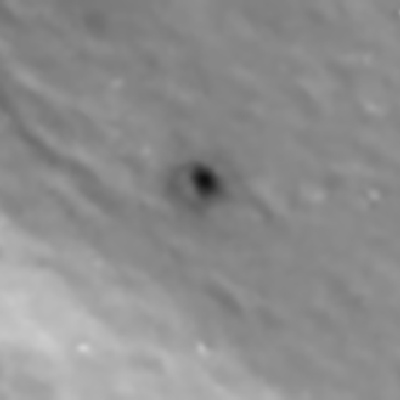Locked in a gravitational dance between Jupiter and the giant planet’s three other Galilean satellites, Io sputters out sulfuric plumes and molten rock. Eruptions from more than 400 volcanoes constantly rework the moon’s tortured surface with new material. Images from NASA’s Voyager and Galileo missions had all painted the same picture: Unlike every other moon, Io had no impact craters, just a perpetually transformed landscape.
The dark scar suggests astronomers may need to revise their understanding of Io’s geological processes.
Now, that portrait of Io may have changed. Jesper Sandberg, an amateur astronomer scouring a photograph taken by Galileo’s Solid-State Imaging (SSI) camera in October 2001, has reported the potential discovery of a small impact crater. The dark scar, about 100 meters wide, suggests astronomers may need to revise their understanding of Io’s geological processes.
Galileo mission scientists David Williams and Rosaly Lopes were intrigued by the possible new crater and its implications. They copresented an analysis of Sandberg’s findings at AGU’s Fall Meeting 2023.
Needle in a Volcanic Haystack
“I’ve seen that image many, many times, but we just didn’t have that on the radar.”
Last winter at his home in Stockholm, Sweden, Sandberg was examining a Flickr gallery of Galileo’s processed images. One of the images was of a wasteland on Io near a mountain called Telegonus Mensae. He noticed a little hole about 7 or 8 pixels wide, which no scientist, to his knowledge, had yet annotated. Sandberg, a major devotee of volcanoes, first considered it an eruption scar.
“I thought, ‘Oh, it must be a collapsed lava tube or something,’” he said. “But then I discovered this ejecta. So maybe it could be an impact crater.”
Excited by the strange mark, Sandberg reached out to Lopes, a planetary geologist at NASA’s Jet Propulsion Laboratory in Pasadena, Calif. The circular shape stood out to her, so she contacted her colleague Williams, a research professor at Arizona State University. Together, they closely inspected the image.
“I actually processed the Galileo SSI mosaics from that time,” said Williams. “I went back, pulled it up, and looked up close—sure enough, there’s a spot that could easily be interpreted as an impact crater.”
The spot’s roundness is telling, Williams said; an irregular shape could have pointed to a volcanic crater. Combined with its isolated location away from a lava flow, Williams is confident that Sandberg found something significant on Io’s surface.
Other colleagues have now weighed in. “I’ve seen that image many, many times, but we just didn’t have that on the radar,” remarked Jani Radebaugh, a planetary geologist at Brigham Young University who studied Galileo’s first images of Io as a graduate student. The bowl-shaped depression far from surrounding terrain could be interpreted as an impact crater, she said.

But at the image’s resolution, it is hard to truly distinguish an impact crater from a volcanic one, said Tracy Gregg, a planetary volcanologist at the University at Buffalo. She is impressed by the symmetry of the circular hole, but the dark material around the depression could arise from a volcanic outburst as well as an impact’s ejecta, she explained.
“We don’t have the data we need to confirm one way or another,” Gregg said. And, she added, by the time the next space probe arrives, volcanic deposits may have already covered it up.
Future Eyes on Io?
The presence of one such crater on Io suggests there may be a hidden population of others, said Lopes. Accounting for those impacts would help scientists develop better models of the moon’s violent geological history.
Only a future mission could image Io at the resolution needed to unveil more craters, Williams noted. That is a challenging and costly prospect: The intense radiation belt encircling Io would wreak havoc on a close orbiter. But a comprehensive flyby from a Jupiter orbiter like NASA’s Europa Clipper mission, launching next year, might suffice.
In the meantime, Sandberg continues to prowl the photo archives. “I have been looking at [these photos] for many years,” he said. “I’m never tired; I constantly discover new details. That’s how I found it.”
—Chiara Villanueva (@chiiavilla), Science Writer
This news article is included in our ENGAGE resource for educators seeking science news for their classroom lessons. Browse all ENGAGE articles, and share with your fellow educators how you integrated the article into an activity in the comments section below.



